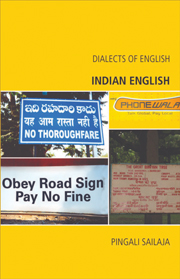Book contents
- Frontmatter
- Contents
- Preface
- Acknowledgements
- Abbreviations, Symbols and other Notational Conventions Used
- 1 Introduction
- 2 Phonetics and Phonology
- 3 Morphosyntax
- 4 Lexis and Discourse
- 5 History and Changes in Progress
- 6 Survey of Previous Work and Annotated Bibliography
- 7 Sample Texts
- Bibliography of Cited Works
- Index
1 - Introduction
Published online by Cambridge University Press: 05 August 2013
- Frontmatter
- Contents
- Preface
- Acknowledgements
- Abbreviations, Symbols and other Notational Conventions Used
- 1 Introduction
- 2 Phonetics and Phonology
- 3 Morphosyntax
- 4 Lexis and Discourse
- 5 History and Changes in Progress
- 6 Survey of Previous Work and Annotated Bibliography
- 7 Sample Texts
- Bibliography of Cited Works
- Index
Summary
Four hundred years after the first Englishman settled in India, followed by two hundred years of colonial rule and sixty years after Indian Independence, English emerges as the most visible legacy of the British. In the streets of all but the smaller villages, it is possible for perfect strangers to communicate, even if minimally, using this language.
Geography
India is the largest of all the countries in the Indian subcontinent, the other nations being Pakistan, Bangladesh, Nepal, Bhutan and Sri Lanka. India is surrounded by the sea on three sides – on the west by the Arabian Sea, on the east by the Bay of Bengal and on the south by the Indian Ocean. Sri Lanka, an island nation, is its closest neighbour in the south and it is separated from India by the Palk Strait. The north has a major boundary in the form of the mountain range of the Himalayas. In the north too are Nepal and Bhutan which are mountain nations. India is linked with Bangladesh on the east. In the north-east, it shares a boundary with Myanmar (erstwhile Burma). Pakistan lies to the west. In the Himalayas, India shares a boundary with China; the boundaries with Pakistan and China are disputed. With an area of 3.3 million square kilometres, India ranks as the seventh largest country in the world and second in Asia, after China (Government of India 2005).
- Type
- Chapter
- Information
- Indian English , pp. 1 - 16Publisher: Edinburgh University PressPrint publication year: 2009

